View in other NatureServe Network Field Guides
NatureServe
Montana
Utah
Wyoming
Idaho
Wisconsin
British Columbia
South Carolina
Yukon
California
New York
Perennial Pepperweed - Lepidium latifolium
Other Names:
Tall Pepperweed, Broadleaf Pepperweed, Broadleaved Pepperweed, Broad-leaf Pepper-grass, Broadleaf Peppergrass
State Rank Reason (see State Rank above)
Lepidium latifolium is a plant native to southeastern Europe and western Asia and introduced into North America (FNA 2010). A conservation status rank is not applicable (SNA) because the plant is an exotic (non-native) in Montana that is not a suitable target for conservation activities.
General Description
PLANTS: Rhizomatous perennial forbs with stiff stems that grow erect, branch above the ground, and are 40-100 cm tall. The lower stems are semi-woody. Plants lack hairs (Lesica et al. 2012) though the Flora of North America (FNA 2010) states they can be pubescent. Sources: FNA 2010; Lesica et al. 2012
LEAVES: Leaves are bright green to grey-green. Basal leaves are petiolate with narrowly oval-shaped blades that have toothed (serrate) margins and are 1-9(14) cm long. Basal leaves wither by flowering time. Stem leaves are alternately arranged with short petioles becoming sessile. Stem blades are oblong to elliptic-ovate or lanceolate, 2-9 cm long by 3-45 mm wide with a cuneate base (that is not auriculate) and with entire to serrate margins. Sources: FNA 2010; Lesica et al. 2012
INFLORESCENCE: Flowers are clustered in branched racemes. Flowers have 4 white petals of 1.5–2 mm long, 4 greenish-white sepals of 1-1.4 mm long, stamens 6 (4 long and 2 short), and 1 pistil. Sources: FNA 2010; Lesica et al. 2012
Phenology
Flowering June through September (FNA 2010).
Diagnostic Characteristics
There are many white-flowered species in the Mustard Family, both native and exotic. It is recommended that identifications be made using a plant manual designed for Montana. Mustards have flowers with 4 sepals, 4 petals, and 6 stamens (4 long and 2 short) among other characteristics.
Perennial Pepperweed –
Lepidium latifolium, exotic and Noxious:
* White-flowered plants that grow from creeping roots (rhizomes) and have mature silicles (fruits) that are not notched at their tip.
* Silicles are glabrous or sparsely pilose (long soft hairs) with a very short style of 0.1 mm long or less. Silicle stems (pedicels) are 2-5 mm long.
* Stem leaves are sessile, but do not clasp around the stem.
Whitetop –
Lepidium draba, exotic and Noxious:
* White-flowered plants that grow from creeping roots (rhizomes) and have mature silicles (fruits) that are not notched at their tip.
* Silicles are glabrous (lack hairs), flattened, and their base is cordate (heart-shaped or indented). Silicles are tipped with a style of 1-1.5 mm long. Silicle stems (pedicels) are 5-12 mm long.
* Stem leaves are auriculate (lobed like an arrow) and clasping around the stem.
Globe-podded Whitetop –
Lepidium appelianum, exotic:
* White-flowered plants that grow from creeping roots (rhizomes) and have mature silicles (fruits) that are not notched at their tip.
* Silicles are pubescent (have hairs), inflated (globe-shaped), and with a short style of 0.4-1.0 mm long. Silicle stems (pedicels) are 4-11 mm long.
* Stem leaves are auriculate (lobed like an arrow) and clasping around the stem.
Lenspod Whitetop –
Lepidium chalepense, exotic:
* White-flowered plants that grow from creeping roots (rhizomes) and have mature silicles (fruits) that are not notched at their tip.
* Silicles are glabrous (lack hairs), partially inflated and round (compressed-globose), not cordate (is pointed to its stem), and topped with a style 1-2 mm long. Silicle stems (pedicels) are 8-15 mm long.
* Stem leaves are auriculate (lobed like an arrow) and clasping around the stem.
The other Montana
Lepidium species (using MTNHP preferred name) have mature silicles with a notch of at least 0.1 mm deep at their top
and are not rhizomatous.
Hoary False-alyssum –
Berteroa incana, exotic and Noxious:
* White-flowered, annual plants that grow from taproots and have mature silicles (fruits) that are not notched at their tip.
* Each of the 4 petals are notched, making the flower appear 8-petaled.
* Plants have star-shaped hairs; whereas,
Lepidium species have simple hairs or none.
* Stem leaves are widest near their tip (oblanceolate), sessile on the stem, and point upwards.
Field Pennycress –
Thlaspi arvense, exotic:
* Easily differentiated if in fruit and easily confused with other species if only of leaves.
* White-flowered, annual plants that grow from taproots and have mature silicles (fruits) that are large, deeply notched at their tip, flat, and with wide wings, resembling a penny.
* Lower stem leaves have petioles. Upper stem leaves are sessile, clasping, auriculate (lobed like an arrow), and with smooth to toothed margins.
Common Yarrow –
Achillea millifolium, native and desirable:
* Member of the Aster/Sunflower Family.
* Bright-white flowers arranged closely in a flat-topped inflorescence.
* Leaves are 2-3 times pinnately dissected, appearing fern-like or bushy like a squirrel’s tail.
Sources: Jacobs and Mangold 2007; FNA 2010; Graves-Medley and Mangold 2011; Lesica et al. 2012.
Species Range
Montana Range
Range Descriptions
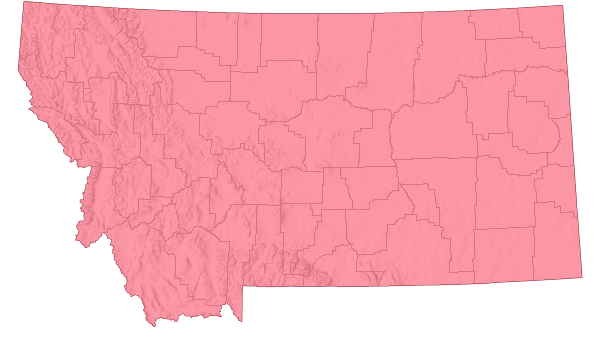
 Non-native
Non-native
Range Comments
Introduced throughout temperate North America; native to Eurasia (Lesica et al. 2012).
For maps and other distributional information on non-native species see:
Nonindigenous Aquatic Species Database from the U.S. Geological Survey
Invasive Species Habitat Tool (INHABIT) from the U.S. Geological Survey
Invasive Species Compendium from the Centre for Agriculture and Bioscience International (CABI)
EDDMapS Species Information EDDMapS Species Information
Observations in Montana Natural Heritage Program Database
Number of Observations: 24014
(Click on the following maps and charts to see full sized version)
Map Help and Descriptions
Relative Density
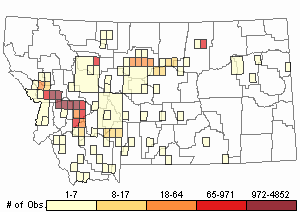
Recency
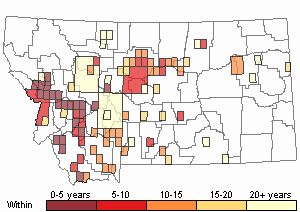
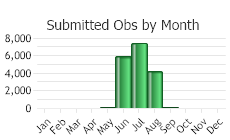
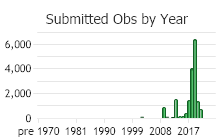
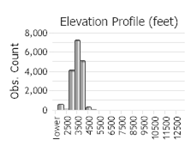 (Observations spanning multiple months or years are excluded from time charts)
(Observations spanning multiple months or years are excluded from time charts)
Habitat
In Montana Perennial Pepperweed grows in riparian areas that are moist or periodically flood, but can adapt to drier upland conditions (Jacobs and Mangold 2007). It can grow along lake shores and in riparian areas, wetlands, fields, pastures, grasslands, rangelands, roadsides, and urban areas in valleys (Jacobs and Mangold 2007; Lesica et al. 2012).
Ecology
Plants grow more abundantly and produce more foliage where nutrient inputs are higher, particularly in response to increase phosphorous (Jacobs and Mangold 2007). In addition, the structure of its rhizomes are dense and coarse with few fine roots, which suggests it requires high-nutrient substrates.
Dense canopy and build-up of its litter can smother or shade-out desirable plants (Jacobs and Mangold 2007).
Perennial pepperweed is saline tolerant (Jacobs and Mangold 2007). It is also a salt pump, that is the rhizomes absorb salt from the soil, accumulate it into its leaves, and upon senescence its salty leaves fall to soil. Salinity does not appear to affect seed germination.
CULTURAL USES [Adapted from Jacobs and Mangold 2007.
Perennial Pepperweed is a medicinal and food plant. An infusion of the plant has been used to treat liver and kidney diseases and a skin disease. Roots can be prepared as a substitute for horseradish. Seeds have been used as a condiment.
Reproductive Characteristics
Plants reproduce by seed, rhizomes, and fragmented rhizomes (Jacobs and Mangold 2007). Growth of existing populations likely occurs by rhizomes more than seeds.
FRUITS [Sources: FNA 2010; Lesica et al. 2012]
Pod-like fruits are silicles that ascend from branches. Silicles are rounded to oval, 2–3 mm long, glabrous or sparsely covered with long soft hairs (pilose), and usually not notched. The tip of the fruit retains a very short style, up to 0.1 mm long. The stem of the fruit/flower (pedicel) is 2–5 mm long, glabrous.
Fruits have two chambers that each produce one small reddish-brown seed. Plants can produce up to 1,000 seeds with large infestations estimated at producing over six billion seeds per acre.
ROOTS [Adapted from Jacobs and Mangold 2007]
At the soil surface roots enlarge to form a woody crown from which many stems can grow. Plants are rhizomatous, growing from underground, creeping stems (usually referred to as roots) that have adventitious buds. New shoots and roots grow from the adventitious buds. Adventitous roots can develop in response to flooding; usually developing if inundated for 3 days. The Rhizomatous stems growing densely in the upper two feet of soil, but may grow to depths of 10 feet. New plants can regenerate from root fragments of 5 cm (2 inches) long. Rhizomes that are air-dried in the sun for 3 days can re-sprout if placed in moist soil.
LIFE CYCLE [Adapted from Jacobs and Mangold 2007]
Plants germinate in response to fluctuating temperatures. Seedlings emerge from mid-winter to mid-spring. Established plants can begin growing in late winter through spring (upon good conditions) with adventitious buds on roots developing rosettes. Flowering stems bolt in May. Plants begin flowering in mid-June, continuing into fall as along as conditions are good. Upon pollination fruits develop all summer. At maturity, pods remain on the plants dropping at irregular intervals throughout the winter. Seed produce a mucilaginous coating when wet that likely helps them adhere to substrates and/or survive dry periods. Seeds are reported to have high viability. With a drought or a hard frost stems will die back. Stands as old as 15 years have been reported. Seeds can be dispersed as a contaminant in hay, in water, and by birds and other animals.
Management
An integrated vegetative management approach provides the best long-term control, and requires that land-use objectives and a desired plant community be identified (Shelly et al.
in Sheley and Petroff 1999). Once identified an integrated weed management strategy can be developed. An integrated weed management strategy promotes a weed-resistant plant community and serves other land-use objectives such as livestock forage, wildlife habitat, or recreation can be developed, making control of Perennial Pepperweed possible (Shelly et al.
in Sheley and Petroff 1999).
PREVENTIONPreventing vehicles from driving through and animals from grazing within infested areas will reduce spread. Hay that is weed-free will reduce spread. Maintaining an intact plant community and reducing soil disturbance will prevent or slow down spread.
PHYSICAL and CULTURAL CONTROLS [Adapted from Jacobs and Mangold 2007]
Hand-pulling can be effective for small populations or to eliminate re-growth from a herbicide treatment. Its rhizomatous growth makes it difficult to pull the entire root stem and will stimulate re-growth plus any fragments can re-sprout. Pulled plants must be bagged, dried, and disposed of in the trash, but should really be burned to truly prevent spreading it.
Mowing has been shown to reduce Perennial Pepperweed by 46% for one year. Mowing should occur at the first signs of flowering and at a stubble height of 4 inches or greater. The root’s carbohydrate reserve is at its lowest when the plant begins to flower. A stubble height of at least 4 inches should remove flowers and buds while allowing desirable plants to better survive. Do not mow if plants are in seed because that will increase spread. However, plants will re-sprout and could flower and repeated mowing is likely necessary. A more effective control is to combine mowing with an herbicide treatment.
Tilling will fragment the rhizomes and increase re-sprouting. Repeated tilling without or in combination with an herbicide treatment may control Perennial Pepperweed.
Revegetation that is timed properly with the appropriate desirable plants can create competition to suppress or to prevent re-invasion by Perennial Pepperweed. The Plant Materials Technical Note 46, “Seeding Rates and Recommended Cultivars” and the Extension Bulletin EB19, “Dryland Pasture Species for Montana and Wyoming” might be useful for your project.
CHEMICAL CONTROLS [Adapted from Jacobs and Mangold 2007]
Herbicides are effective, especially when properly integrated with intensive pasture management. The herbicide type and concentration, application time and method, environmental constraints, land use practices, local regulations, and other factors will determine its effectiveness and impact to non-target species. Strict adherence to application requirements defined on the herbicide label will reduce risks to human and environmental health. Consult your County Extension Agent and/or Weed District for information on herbicidal control. Chemical information is also available at
Greenbook.
Perennial Pepperweed has been suppressed for 1-2 years using:
*
Metsulfuron at the 1.0 ounce per acre rate applied to actively growing plants
before full bloom. A nonionic surfactant is needed.
*
Chlorsulfuron at the 1.0 ounce per acre rate applied when plants are in flower bud to early flowering. A nonionic surfactant is needed.
*
Imazapic at the 8-12 ounce per acre rate mixed with methylated seed oil at the 1 quart per acre MSO rate applied after plants are in full bloom.
2,4-D at the rate of 2 quarts per acre will kill stems, but not the root crowns. Root crowns will re-sprout and require a different follow-up treatment.
Glyphosate at the rate of 2 quarts per acre will kill all plants (broad-leaf and grass plants).
GRAZING CONTROLS [Adapted from Jacobs and Mangold 2007]
Cattle and sheep can control Perennial Pepperweed in stands that are not dense. One study found Perennial Pepperweed was reduced in a pasture by 78% for one year. Sheep grazing has reduced Perennial Pepperweed plants without reducing native plant species. Perennial Pepperweed seeds remain viable after passing through the digestive tract. In fact, germination rates increased by 5% to 40% for ingested seeds. Animals that have grazed in areas with Perennial Pepperweed should be contained and fed weed-free forage for 5 days before moving into weed-free areas.
Poisoning has been reported for horses feeding on Perennial Pepperweed contaminated hay.
BIOLOGICAL CONTROLSThere are no biological controls available because Perennial Pepperweed is a member of the mustard family, which includes numerous important crops (cabbages, broccoli, mustard, canola, and others).
Useful Links:Central and Eastern Montana Invasive Species TeamMontana Invasive Species websiteMontana Biological Weed Control Coordination ProjectMontana Department of Agriculture - Noxious WeedsMontana Weed Control AssociationMontana Weed Control Association Contacts WebpageMontana Fish, Wildlife, and Parks - Noxious WeedsMontana State University Integrated Pest Management ExtensionWeed Publications at Montana State University Extension - MontGuidesStewardship Responsibility
Threats or Limiting Factors
* In high nutrient environments, especially, Perennial Pepperweed grows dense and will shade-out desirable vegetation.
* Leaf litter can become thick, making it difficult for desirable plants to germinate.
* Infestations displace nutritive forage plants; thereby, decreasing the livestock carrying capacity.
* Infestations in riparian and other habitats reduce the quantity and quality of forage available for wildlife and bird species.
* Infestations decrease native plant diversity.
References
- Literature Cited AboveLegend:
 View Online Publication
View Online Publication Lesica, P., M.T. Lavin, and P.F. Stickney. 2012. Manual of Montana Vascular Plants. Fort Worth, TX: BRIT Press. viii + 771 p.
Lesica, P., M.T. Lavin, and P.F. Stickney. 2012. Manual of Montana Vascular Plants. Fort Worth, TX: BRIT Press. viii + 771 p. Sheley, Roger, and Janet Petroff. 1999. Biology and Management of Noxious Rangeland Weeds. Oregon State University Press, Corvallis, Oregon.
Sheley, Roger, and Janet Petroff. 1999. Biology and Management of Noxious Rangeland Weeds. Oregon State University Press, Corvallis, Oregon.
- Additional ReferencesLegend:
 View Online Publication
View Online Publication
Do you know of a citation we're missing? Lesica, P., M.T. Lavin, and P.F. Stickney. 2022. Manual of Montana Vascular Plants, Second Edition. Fort Worth, TX: BRIT Press. viii + 779 p.
Lesica, P., M.T. Lavin, and P.F. Stickney. 2022. Manual of Montana Vascular Plants, Second Edition. Fort Worth, TX: BRIT Press. viii + 779 p. Quire, R.L. 2013. The sagebrush steppe of Montana and southeastern Idaho shows evidence of high native plant diversity, stability, and resistance to the detrimental effects of nonnative plant species. M.Sc. Thesis. Bozeman, MT: Montana State University. 124 p.
Quire, R.L. 2013. The sagebrush steppe of Montana and southeastern Idaho shows evidence of high native plant diversity, stability, and resistance to the detrimental effects of nonnative plant species. M.Sc. Thesis. Bozeman, MT: Montana State University. 124 p. Sater, S. 2022. The insects of Sevenmile Creek, a pictorial guide to their diversity and ecology. Undergraduate Thesis. Helena, MT: Carroll College. 242 p.
Sater, S. 2022. The insects of Sevenmile Creek, a pictorial guide to their diversity and ecology. Undergraduate Thesis. Helena, MT: Carroll College. 242 p.
- Web Search Engines for Articles on "Perennial Pepperweed"





